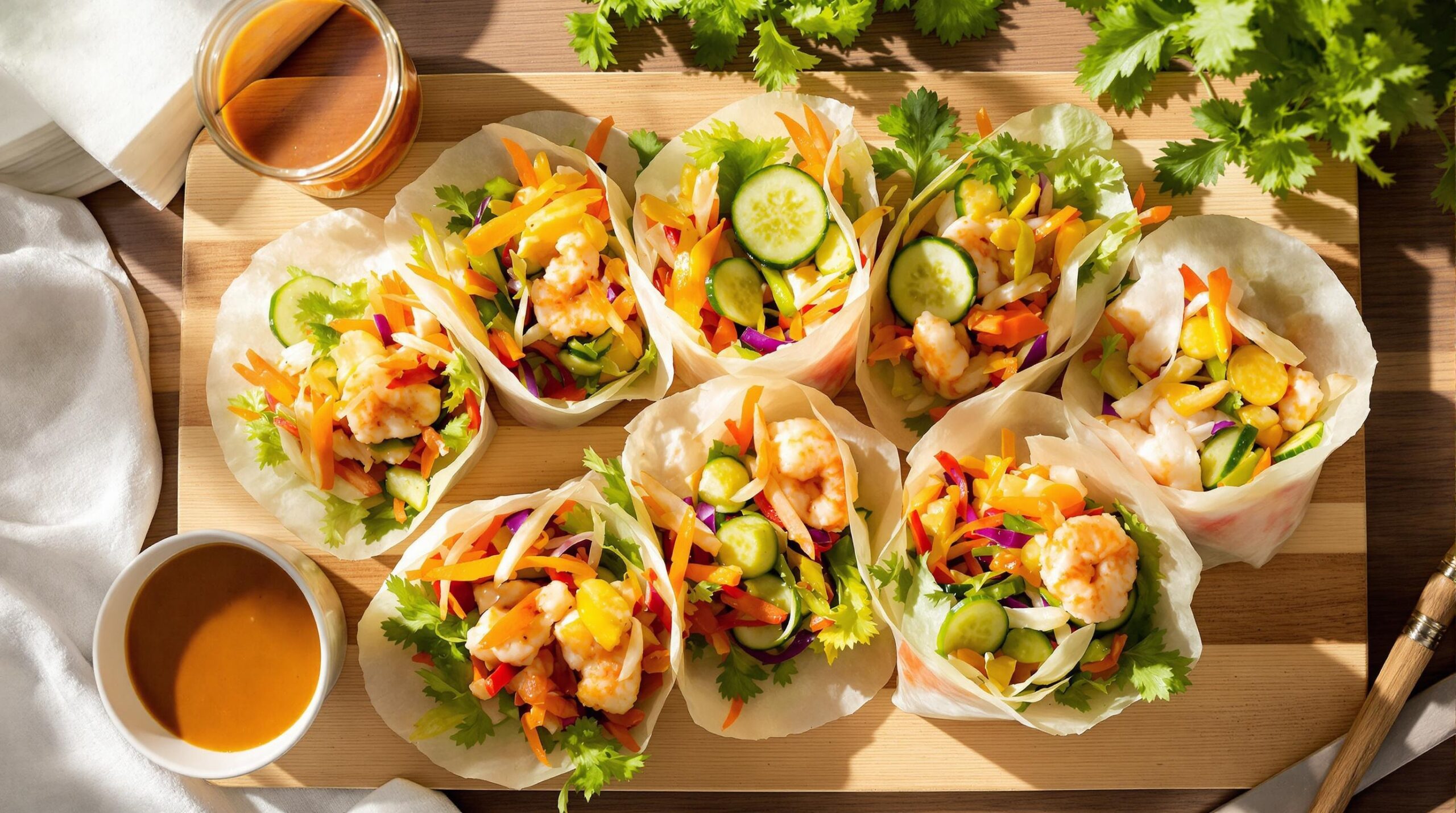Rice paper rolls are a versatile and delicious option for quick weeknight meals. Their adaptability suits various dietary preferences while providing a healthy choice. With a little practice, mastering rice paper roll recipes becomes straightforward. Today, we’ll guide you through essential techniques and offer exciting filling ideas for delicious rice paper rolls.
The Basics of Rice Paper Rolls
Understanding the fundamental ingredients of rice paper rolls is key. Rice paper sheets are the primary component, typically made from flour, water, and salt. These transparent, edible sheets require soaking in water to soften before use. This simple step is crucial for easy rolling and handling.
Fresh, vibrant fillings elevate rice paper rolls. Common ingredients include vegetables, protein sources, and herbs. Traditional choices feature carrots, cucumbers, bell peppers, cooked shrimp, tofu, mint, and cilantro. Dips and sauces are equally essential. Peanut sauce and hoisin-based dips complement the rolls perfectly.
Preparing Rice Paper Rolls Properly
Success with rice paper rolls begins with a proper setup. Organize ingredients and make them easily accessible. Cut vegetables into thin, even strips to ensure seamless rolling. Arrange vegetables, proteins, and herbs in separate sections for efficiency. Preparing sauce and dip ingredients beforehand saves valuable time.
Soak each rice paper sheet in warm water for five to ten seconds. Any longer, and you risk oversoaking, which can cause tears during rolling. Once pliable, place the sheet on a damp towel or clean work surface. The damp surface prevents sticking, making the rolling process smoother.
Rolling Techniques for Perfect Rice Paper Rolls
Mastering the rolling technique may take some practice, but it’s crucial for neat rolls. Start by placing desired fillings across the lower third of the softened rice paper. Leave adequate space on the sides to ensure a tidy roll. Gently fold the bottom edge over the fillings, tucking them snugly inside. Next, fold the sides inward, encasing the fillings completely. Finally, roll the paper tightly from bottom to top to form a compact roll.
Adjust the filling amounts to avoid overstuffing, which can make rolling difficult. Rolls should be consistent and manageable in size. This ensures an even distribution of ingredients and enhances the visual appeal.
Exploring Flavorful Filling Combinations
Experimenting with different filling combinations allows for exciting culinary adventures. Start with classic options like shrimp, vermicelli noodles, and fresh vegetables. The simplicity of these ingredients creates a light yet satisfying roll. For a vegetarian twist, replace shrimp with marinated tofu or tempeh.
For bold flavors, explore fusion-style fillings. Korean-style beef bulgogi or barbecued chicken provides an exciting twist. Cucumbers, bell peppers, and sesame seeds complement these proteins beautifully. To elevate flavors further, offer an array of fresh herbs like basil, mint, and Thai basil.
Dips and Sauces for Extra Flavor
Sauces play a crucial role in the overall enjoyment of rice paper rolls. Balance flavors with carefully selected dips. Peanut sauce, a classic choice, adds a rich, nutty flavor complementing various fillings. Create peanut sauce by blending creamy peanut butter, soy sauce, lime juice, hoisin sauce, and a touch of sugar.
For a more tangy and savory option, consider a hoisin-based dipping sauce. Combine hoisin sauce, rice vinegar, garlic, and sriracha for a flavorful condiment. Experiment with custom sauces by adding ginger, garlic, or chili to adjust flavor profiles to your liking. Offering multiple dips ensures guests can select their preferred tastes, enhancing the meal experience.
Ensuring Freshness and Presentation
Proper presentation enhances the appeal of rice paper rolls. Serve them with colorful vegetables, herbs, and sauces arranged around rolls on a platter. Keeping rolls fresh is equally important. If not serving immediately, place a damp paper towel over them; this prevents drying out. Storing rolls in the refrigerator, lightly covered, maintains freshness overnight.
Cut rolls in half to reveal vibrant fillings, making them more attractive and easier to handle. Arranging cut rolls strategically on the serving platter accentuates contrasting colors and textures.
Troubleshooting Common Issues
Even with preparation, issues might occur. Sticking and tearing rice paper can be frustrating but fixable. Rolling surfaces must remain damp to prevent sticking. If the paper tears, gently patch it with another small piece of softened rice paper. Avoid letting sheets stick together; it complicates separation and rolling.
Overstuffed rolls are more complex to seal and may split. Avoid these problems by using a moderate amount of fillings and rolling tightly. With time and practice, these issues will diminish as you become more adept.
Advantages of Rice Paper Rolls for Weeknight Dinners
Rice paper rolls boast numerous advantages, making them ideal for weeknight dinners. They require minimal cooking, allowing meals to come together quickly. The hands-on, customizable nature invites family collaboration. Everyone personalizes their rolls, accommodating various preferences and dietary needs.
Another benefit is nutrition. Fresh vegetables, lean proteins, and minimal added fats make them healthier than takeout alternatives. Their light yet satisfying nature leaves those partaking both content and energized.
Embracing Versatility in Rice Paper Rolls
Versatility remains a significant attraction for rice paper rolls. You can switch up fillings, proteins, and sauces to suit taste preferences, dietary requirements, or available ingredients. This adaptability makes rice paper rolls an ideal platform for culinary creativity. Experimenting with flavors from different cuisines keeps weeknight dinners exciting. Try incorporating Mediterranean or Mexican ingredients for unexpected yet delightful variations.
Conclusion: Enjoying the Mastery of Rice Paper Rolls
Mastering rice paper roll recipes promises exciting culinary journeys for quick weeknight meals. As you become proficient, preparing these versatile rolls transforms from a skill into an enjoyable process. Whether embracing classic flavors or inventing new combinations, rice paper rolls remain a beloved go-to meal option.
With practice, confidence in preparation grows. Invite family and friends to share this delightful experience, turning ordinary weeknights into extraordinary culinary endeavors. With some creativity and practice, rice paper rolls will become a treasured addition to your meal repertoire. Let’s continue this culinary journey and enjoy crafting delicious rice paper rolls together.

